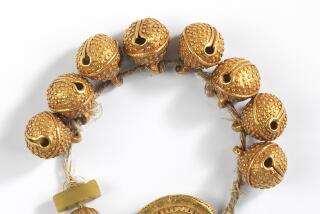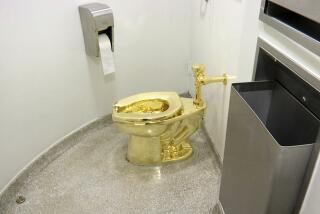Country Reeks With Historic Nooks and Crannies : In Britain, Rare Finds in Improbable Places
- Share via
LONDON — Schoolboy David Phoenix saw something glint under the water as he walked by a stream in Lancashire. He bent down and fished it out.
“It looked like an old bottle top,” he said, but it was a 15th-Century Indian gold coin and it’s now in the British Museum.
“We don’t yet know which ruler issued it, as his name on the edge is encrusted and it’s still being cleaned,” said Sarah Wadley, a museum spokeswoman. “The coin will go back to the finder,” she said.
David, 15, won’t know what his coin is worth unless he offers it to a dealer or sends it to auction, because the museum does not publicly value objects. However, he now knows that treasure isn’t always buried by pirates.
A Fortune in a Pot
Britain has 2,000 years of recorded history and a people who journeyed to the far ends of the Earth, so sometimes finding treasure is as simple as running a metal detector around a historic site. An unidentified farm worker recently did that and found 48,000 Roman coins, lying for 17 centuries in a pot in a field near Lincoln, the second-largest Roman hoard discovered in Britain.
“Finding valuable things by chance happens more regularly than most people imagine,” said Beth McHattie at Sotheby’s, the art auctioneers.
“The one that’s best remembered nowadays is the little Ming Dynasty bowl we sold for 291,000 pounds (then $690,000) in 1980. Only three others like it are known in the world.
“The widow who owned it got it from a relative who had been to China at the turn of the century. She hadn’t a clue about its value and was using it as a plant pot outside her cottage in Dorset.”
Varied Routes to Riches
Other treasures turned up in Britain in recent years were found on an embassy ceiling, in a farmhouse roof, on a city hall floor and on a garbage dump--some through diligent search, some by chance.
David Carrtitt of Christie’s, Sotheby’s rival, found a lost painting, the “Allegory With Venus and Time” by Giovanni Battista Tiepolo, on the ceiling of the Egyptian Embassy in 1969.
London’s National Gallery paid almost $1 million for it.
Carrtitt knew the painting existed, but not where. He found it by tracing the buildings in which the original owners and their descendants had lived.
Malcolm Laws, a farmer in Bideford, in Devon, was helping his parents restore their old farmhouse when he found a spoon in the roofing.
“It was covered in tar and was such an odd shape that I thought it was just a piece of junk,” Laws said.
He sent it to Phillips, Britain’s third-ranking auction house. They said it was 600 years old and sold it for 13,000 pounds ($24,300) in 1982.
Hiding valuables in the roof was customary in times of unrest, and the spoon may have been there since the civil war of the 1640s.
‘Some American Woman’
A couple looking through books on the floor of Wells City Hall in Somerset during a Christmas bazaar five years ago found a Victorian painting of ancient Egypt, which they thought was “rather pretty.” They paid 5 pounds (then $11.75) for it and hung it on their wall, paying no attention to the signature, Alma-Tadema, who they thought was probably “some American woman.”
A friend said they should send it to auction. The artist was the once-again fashionable Sir Lawrence Alma-Tadema and the picture sold for 49,500 pounds (nearly $74,000) in November at Sotheby’s. It belonged in 1897 to the super-rich William H. Vanderbilt in New York and had gone unrecorded since 1903.
Scrap dealer Jim Wookey, salvaging a garbage heap in Lancashire in 1967, found a 17th-Century manuscript called “Commentaries of Heaven” by the poet Thomas Traherne. It was about to go up in flames and its binding was already scorched, but the British Library bought it for $110,000 at auction.
A Little Orwellian
Scripts for World War II radio talks by George Orwell were found last year by William West, a fan of the celebrated writer, in the British Broadcasting Corp. archives, where they had been filed under the name of the announcer who introduced them on the air. West turned them into a book.
Money is not the upshot of every disovery. “The Book of Fines,” a register of real estate transactions in Taunton, Somerset, in 1641-48, was borrowed from the Somerset county records office by a bishop of Winchester.
It sat in his office for 200 years, then passed on to the Church Commissioners, who look after the Church of England’s finances. They had it for about a century before sending it to the records office in Hampshire, where the bishop used to live. It stayed there for several years before it was spotted by an archivist who had once worked at the Somerset office. He sent it to its rightful home last March.
“We knew it went missing in the middle of the 17th Century,” a Somerset official said, “but we never knew where.”
More to Read
Sign up for Essential California
The most important California stories and recommendations in your inbox every morning.
You may occasionally receive promotional content from the Los Angeles Times.













